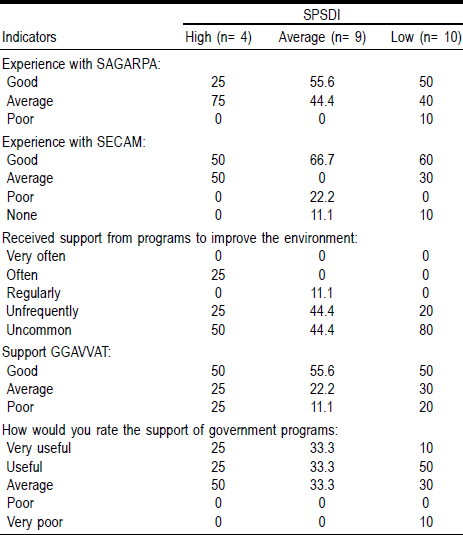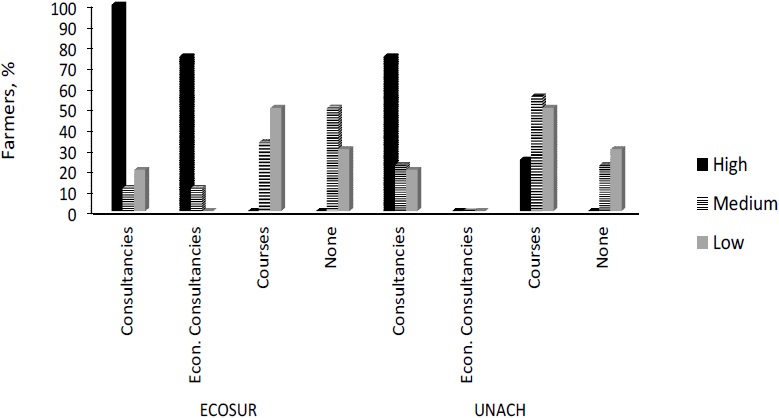Services on Demand
Journal
Article
Indicators
-
 Cited by SciELO
Cited by SciELO -
 Access statistics
Access statistics
Related links
-
 Similars in
SciELO
Similars in
SciELO
Share
Revista mexicana de ciencias pecuarias
On-line version ISSN 2448-6698Print version ISSN 2007-1124
Rev. mex. de cienc. pecuarias vol.7 n.4 Mérida Oct./Dec. 2016
Articles
Adoption of silvopastoral systems and the sociocultural context of producers: support and limitations
a Facultad de Medicina Veterinaria y Zootecnia. Universidad Autónoma de Chiapas. Rancho San Francisco Km. 8 Carretera Ejido Emiliano Zapata, Tuxtla Gutiérrez, Chiapas. México.
b Departamento de Agricultura, Sociedad y Ambiente. El Colegio de la Frontera Sur. San Cristóbal de las Casas, Chiapas. México.
c Programa de Ganadería, IREGEP. Colegio de Postgraduados. Montecillo, Texcoco, Estado de México. México.
d Facultad de Ciencias Agrícolas. Universidad Autónoma de Chiapas. Huehuetán, Chiapas. México.
The objective was to identify perceptions of farmers from Mezcalapa, Chiapas regarding the influence of personal and sociocultural factors, as well as support from the government and academic institutions in adoption of silvopastoral systems (SPS). A semi-structured questionnaire was applied to 23 farmers, whose answers were verified in the field. An SPSS analysis showed three conglomerates with high, medium and low levels of the SPS development index (SPSDI). Differences (P<0.05) were found regarding area covered by SPS technician and for linear meters of living fence per hectare among the three levels of SPSDI. On average, 71 % of farmers believe they know somewhat or little regarding SPS. Eighty six (86) percent believe that younger generations are not interested in farming. Support from Technology Transfer and Validation Farmer Group advisors was satisfactory for 50 % of farmers but they indicated that such support has been temporary. One hundred percent, 74 % and 62 % of farmers with high, medium and low SPSDI, have received support from academic institutions. Eighty six % of farmers have insufficient income to purchase agricultural inputs. Farmer’s receive $ 4.20 Mexican pesos per liter of milk and 67 % indicate that their income barely covers their needs. Interventions by intermediaries (middlemen) negatively affect 93 % of these farmers. Age, educational level, extra income, low levels of government support, and farmer´s lack of knowledge have limited adoption of SPS; therefore complementary support from academic institutions has played a critical role for these farmers.
Key words: Technology adoption; Silvopastoral systems; Milk production; Tropics
El objetivo del estudio fue conocer la percepción de los productores de Mezcalapa, Chiapas, sobre la influencia de los factores: personal, sociocultural, apoyos gubernamentales y de instituciones académicas, en la adopción de los sistemas silvopastoriles (SSP). Se aplicó un cuestionario semi-estructurado a 23 productores, cuyas respuestas se verificaron en campo. El análisis mediante SPSS resultó en tres conglomerados con niveles alto, medio y bajo de desarrollo. Hubo diferencia (P<0.05), respecto a la superficie cubierta de los SSP tecnificados (ha) y los metros lineales de cerco vivo por hectárea, entre los tres niveles del índice de desarrollo de los SSP (IDESSP) (P<0.05). En promedio, el 71 % de los productores considera saber regular o poco sobre los SSP. El 86 % de ellos opinó que las generaciones más jóvenes no tienen interés ni apego al campo. El apoyo de asesores con el modelo GGAVATT fue bueno para el 50 % de ellos, pero indicaron que ha sido temporal. El 100, 74 y 62 % de los productores con IDESSP alto, medio y bajo, respectivamente, han recibido apoyos de instituciones como ECOSUR y la UNACH. Los insumos agropecuarios, son poco accesibles para el 86 % de ellos. Reciben $ 4.20 por litro de leche y el 67 % indicó que sus ingresos apenas cubren sus necesidades. Para el 93 % de ellos el nivel de intermediarismo (coyotaje) les afecta. La edad, escolaridad, ingreso extra, escasos apoyos gubernamentales y falta de conocimiento de los productores, ha limitado la adopción en los SSP, en tanto que el apoyo complementario de instituciones académicas fue importante.
Palabras clave: Adopción de tecnología; Sistemas silvopastoriles; Producción de leche; Trópico
Introduction
In the Mexican tropics, animal production system based on extensive grazing is most widely used because it is the most economical way of feeding; however, pasture degradation is a major threat to the sustainability of the system. This is mainly due to management factors among which are: burning to stimulate pasture growth, the use of agrochemicals, inadequate grazing management (grazing intensity, grazing interval and animal carrying capacity of pastures) which consequently reduce productivity and profitability of these systems, due to increased acquisition of external inputs for animal management. This causes the expansion of the cattle frontier, which involves the deforestation of forests and reduction of environmental services from these ecosystems that contribute to global warming currently affecting the planet1.
An alternative for sustainable farming, are silvopastoral systems (SPS), which are based on the interaction of woody perennials (trees or shrubs), herbaceous legumes and grasses in different arrangements and layers for feeding cattle2 . In Latin America, SPS have operated for more than two decades, with positive results for the producer and the environment. These include increased production of meat and milk, reduced use of external inputs, animal loads higher per hectare reforestation, mitigation of greenhouse gases, reduced soil erosion, conservation of water sources and the restoration of flora and fauna1,3. However, shortage in capital funding for establishment and lack of technical assistance are considered the main barriers to the adoption of these systems4. Among the projects with the greatest impact and success for the establishment of SPS, is the Silvopastoral Integrated Approaches for Ecosystem Management (2002-2007). It has been carried out in Costa Rica, Colombia and Nicaragua, and currently with the Colombian Sustainable Livestock Project (2010-2017). These projects are mainly based on providing technical assistance and incentive payments for environmental services (PES) in collaboration with research institutions and government have influenced the adoption of the SPS5.
In Mexico, the Network of Intensive Silvopastoral Systems (iSPS) led by the Centre for Research on Sustainable Agricultural Production Systems (CIPAV) of Colombia and the Fundación Produce A.C. of the state of Michoacan, in conjunction with National academic institutions and the Secretariat of Agriculture, Livestock, Rural Development, Fisheries and Food (SAGARPA) were able to establish about 10 thousand hectares of iSPS in 15 states in the Republic in less than four years by offering seeds, technical assistance and financial incentives6. In Chiapas, support programs for livestock are offered by SAGARPA (incentives program livestock productivity, PROGAN 2003) and the Secretariat of the Farm (SECAM) through the model Farm Group for Validation and Technology Transfer (GGAVATT). Recently (2005), the Colegio de la Frontera Sur (ECOSUR) and the Universidad Autónoma de Chiapas (UNACH) in conjunction with the above institutions have hosted workshops, courses for producers and advisors GGAVATT, conferences and research projects in the northeastern part of the state, highlighting the potential for development of iSPS in this area7,8. However, despite these efforts and studies on technological, economic and environmental impacts of SPS, apparently there is little adoption of these systems, thus the objective of this study was to determine the influence of support factors from governmental and academic institutions, sociocultural and personnel, on the decision of producers to choose whether or not to adopt SPS, from their own perspective.
Material and methods
The study was conducted from September 2012 to November 2013, in the municipality of Mezcalapa, located in the region “III Mezcalapa” state of Chiapas at 17º 08" N and 93º 18" W, 320 m asl. The climate is Af (m) (warm humid with abundant rains in summer), annual average temperature 24 to 26 °C and annual rainfall of 1,932 mm.
To perform the study, an agreement was formally signed with the Society of Rural Production (SRP) Malpaso Group, consisting of 103 producers with livestock units (LUs) specialized in the production of milk. Participating producers had traditional silvopastoral systems (SPS, left to grow trees in their pastures for firewood and shade, have live fences to delimit their pastures or the limits of their ranches, but not for animal feed), and technified SPS (where in addition to traditional activities they have established scattered fodder trees in their pastures, iSPS and protein banks).
From the results of another study in which members of this SRP attended three participatory workshops, a semi-structured questionnaire was constructed that included a section of socio-demographic data that was designed to consider the following factors: governmental aid, academic institutional aid, sociocultural and personnel, according to the methodology of Morgan9. Beforehand calibration and adjustment was done by applying it to 23 producers (22.3 % of the population) in their properties to make direct observations and collate the information.
The questionnaire looked at 39 indicators a) Five sociodemographic: sex, age, education, religion and marital status; b) Six related to governmental support, experiences with SAGARPA and SECAM, support to improve the environment, GGAVATT opinion on the program, administrative management to obtain resources and usefulness of these; c) Five for support from academic institutions: consultancy, financial support, teaching courses, experimentation and presence in their ranches; d) nine for the sociocultural: group conceptions, annual earnings and additional income to livestock, level of intermediaries and behavior of younger generations towards farming; e) Seven for the personnel: degree of knowledge of SPS, frequency of introduction of trees, certified organic producer, and with an opinion regarding agricultural inputs.
The data were captured in Excel for cluster k-means analysis, using SPSS Ver. 20, with the livestock units being grouped according to SPS development index (SPSDI). This index was derived from the following indicators: area of grassland with scattered trees and live fences, total number of existing livestock, surface area of technified SPS, linear meters of live fences and total area of the ranch. The differences between the levels of the SPSDI were determined by one way analysis of variance and the comparison test of Tukey (P<0.05), and analysis of X2 for nonparametric (SPSS Ver. 20).
Results and discussion
There were three clusters that consisted of three SPSDI levels: high, medium and low, that grouped to 4, 9 and 10 producers, respectively, with LUs with surface area from 10 to 109 ha. There was no difference between the levels of SPSDI indicator for grassland or with scattered trees in terms of cow/ha (P>0.05). However, the differences between them was significant (P<0.05) with surface area of technified SPS and live fences in linear meters per hectare (Table 1).
Table 1 Indicators for Silvopastoral system development index (SPSDI) of livestock units in Mezcalapa, Chiapas

In parenthesis is the standard error. n= population.
abc Values with different letters in the same row are different (P<0.05).
Socio-demographic data
Most producers of LUs irrespective of whether the SPSDI was high, medium and low were male, were married and had an average age of 58.5, 60.7 and 58.2 yr, respectively (Table 2). This indicates that some of them are already or they are about to become seniors, which partly explains the low adoption of SPS, as Salas et al10 reported in northern Mexico, where producers of advanced years were less given to adopt new technologies. Farmers with LUs and high SPSDI were 75 % Catholic, while 55.6 and 60 % with medium and low SPSDI respectively, were Adventists (do not work on saturdays).
Table 2 Socio-demographic data with different Silvopastoral system development index (SPSDI) producers in Mezcalapa, Chiapas
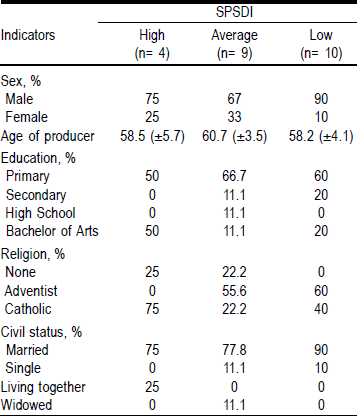
(P>0.05).
It is worth mentioning that 50, 55.6 and 60 % of farmers with high, medium and low SPSDI, respectively, only had primary education. In this regard, a study by Marin et al11 reported that low education is an indicator of poverty that hinders the adoption of the SPS. In the results of the factors, seven indicators were not included in the tables because they were definitive and were alluded to and integrated directly into the discussion.
Government support factor
The results indicated that 75 % of producers with LUs that had high SPSDI said their experience with the SAGARPA was average, while it was good for 55.6 and 50 % of farmers with medium and low SPSDI, this is mainly attributed to the support PROGAN (Table 3). Similarly, 50, 66.7 and 60 % of farmers with high, medium and low SPSDI respectively, reported having had a good experience with the SECAM, possibly due to the technical assistance granted for five years at 50, 70 and 77.8 % of producers with high, medium and low SPSDI, respectively, through GGAVATT program, aimed at certification in the production of organic milk. It is possible that the above, 50, 55.6 and 50 % of farmers with high, medium and low SPSDI respectively, had the opinion that the operation of GGAVATT program had been good but temporary and sufficient to certify the majority of producers who received the counseling. This coincides with a study conducted in Colombia, where trained producers positively influenced the adoption of new technologies12. Thus, focusing on the advice given by GGAVATT, the establishment of SPS increases with the adoption and development of these systems in the region, especially because 50, 44.4 and 80 % of producers in the high, average and low levels of SPSDI reported that they did not often receive aid from programs to improve the environment, which was also limited due to the lack of public policies that promote environmental conservation through the establishment of SPS. This coincides with Casasola et al13 in Costa Rica where they stressed that it is vital to the efficiency of public policies to support economic incentives (payments for environmental services) and technical assistance to incentivize the adoption of the SPS. Moreover, except at the average level of SPSDI, most producers at the remaining two levels indicated that economic support from government programs is useful. Regarding accessibility, they affirmed it is adequate and effective the administrative management to obtain these resources, 50 % of farmers with high SPSDI said that are not easily accessible and they should be allowed not only collective individual procedures, while were accessible and regularly accessible to producers with average (44.4 %) and low (40 %) levels of the SPSDI. The administration was inadequate and effective for 50 % of farmers with high SPSDI, while it was very appropriate and effective for mid-level (44 %) and regularly adequate and effective for low level SPSDI (50 %), which was quite controversial. In addition, they noted that 100 % of the producers at the three levels of SPSDI without health insurance for livestock activities they perform.
Aid factors from academic institutions
In this regard, 100, 70 and 55.6 % of producers with high, medium and low SPSDI, respectively, or have received support from ECOSUR; 75 % of farmers with high SPSDI noted that researchers of ECOSUR use their ranches to develop research, while only 33.3 and 10 % of farmers with medium and low SPSDI have developed such activity (Table 4). High SPSDI producers have received support in the form of instructional assistance and economic, 100 and 75 % respectively. While 33.3 and 50 % of farmers with medium and low SPSDI have only received courses (Figure 1). In addition, 50 % of producers with high SPSDI reported that the presence of ECOSUR on their ranches was average, whereas, there was no presence of this institution on the ranches of 66.6 and 70 % of farmers with medium and low SPSDI. Regarding the intervention of the UNACH, 100, 77.8 and 70 % of farmers with high, medium and low SPSDI respectively, said they have received support from this institution; 75 % of producers with high SPSDI indicated that UNACH uses their ranches for research, while 66.6 and 90 % of farmers with medium and low SPSDI said they have not used their ranches (Table 4). Approximately 75 % of farmers with high SPSDI received instructional advice, however, 55.6 and 50 % of farmers with medium and low SPSDI have only received courses (Figure 1). Similarly, 50 % of producers with high SPSDI noted that the presence of the UNACH on their ranches is high, and as it happened with the previous institution, 55.6 and 70 % of farmers with medium and low SPSDI stated that there was no presence of UNACH in their LUs. According to the above results, it can be noted that producers of high SPSDI have had greater intervention by academic institutions and have received more support in terms of instructional advice, financial aid and presence in their ranches, which justifies having a better developed SPS. This result is consistent with studies in Costa Rica and Colombia where they contended that support that includes technical assistance, plus economic incentives facilitates the adoption of the SPS14,15 and they also mentioned that the involvement of academic institutions is vital for the adoption of these systems16.
Table 4 Intervention of Silvopastoral system development index Silvopastoral System Development Index (SPSDI), in the municipality of Mezcalapa, Chiapas
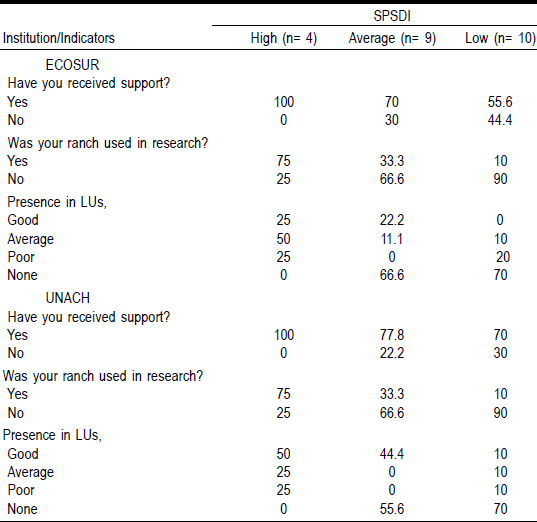
(P>0.05). LUs= Livestock units.
Sociocultural factor
All producers (100 %) with high SPSDI have other income, in addition to livestock, while 77.8 and 60 % of producers with low and medium SPSDI, respectively have as their only source of income livestock production (Figure 2). This suggests that the latter have less opportunity to innovate, due to economic constraints, as reported Aldy et al17, where they argued that producers do not change from traditional, more secure and experienced system to a new technology that could be associated with economic risks. On average, 93 % of the producers of the three SPSDI agreed that there is a high “coyotaje” or middlemen in the sale of animals, reducing income per animal and indirectly hinders the adoption and progress to some type silvopastoral mode. In a study in this same region, the route of marketing of animals sold go through three intermediaries, where the difference between the initial selling price, by the producer, and the final sale price by retailers, is 157 %, which is a high margin for no marketing benefits to the producer; therefore, a permanent public policy aimed at solving the problems of the production chain, leading to circumventing middlemen from the sale of the live animal to the meat in different cuts, which would result in a more just and greater economic gain for the producers18.
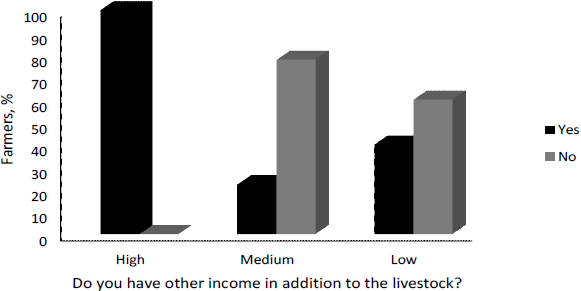
Figure 2 Producers who have income additional to livestock production in Mezcalapa, Chiapas (SPSDI: High, medium and low)
Regarding the perceptions of this group, 50 and 44.4 % of farmers with high and medium SPSDI, expressed total disagreement with that new livestock production systems that are in fashion, while 50 % of producers with low SPSDI favored the new system (Table 5). Farmers with high, medium and low SPSDI, 50, 77.8 and 60 %, respectively, fully agreed that raising livestock only with pasture affects biodiversity. Also, most producers in the three SPSDI levels disagreed and some disagreed strongly that trees affect pasture growth (Table 5). In this regard, in Latin America it has been reported in different studies the belief by producers that grass did not growth under the trees, and is one of the factors limiting the adoption of SPS19,20, which is not an obstacle for most producers according to this study.
Table 5 Sociocultural factor in producers with different Silvopastoral system development index (SPSDI) in Mezcalapa, Chiapas (%)
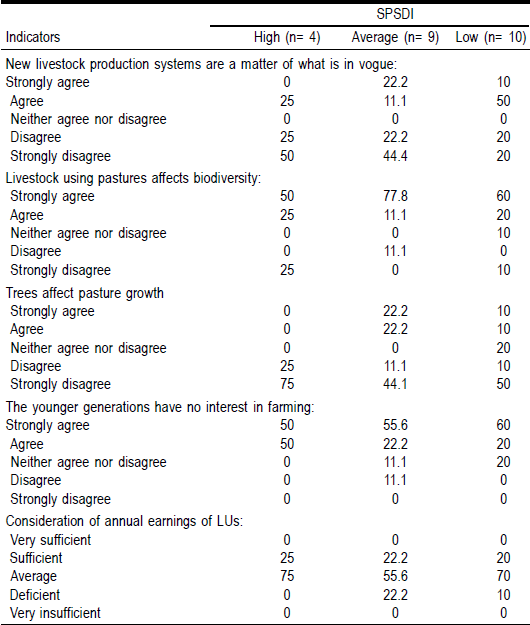
(P>0.05). LUs= Livestock units.
At all three levels of SPSDI, producers agree and fully agree that the younger generations are not interested in farming. This can generate decisions such as selling the ranch or switching to other production systems that involve less effort and cost (that surfaced in previous participatory workshops of this study, to be published in the near future), continuing environmental damage such as deforestation, grassland degradation and soil erosion among others, so that public policy is considered necessary to motivate their permanence or return to the farm once their studies are concluded.
Most producers at the three levels of SPSDI fully agree that they should consider different alternatives to improve the production of the ranch, which is difficult without the support of young people. On the other hand, 75, 55.6 and 70 % of farmers with high, medium and low SPSDI considered that the annual income of their LUs is average and are being affected by the high intermediarism as mentioned above, the low price they are paid for liter of milk ($ 4.20 Mexican pesos) and penalty of 50 % ($ 2.00) of the price if they detect some degree of contamination.
Personnel factors
In relation to the hours that the producer engaged in the activities of the ranch, 50, 66.7 and 50 % of farmers with high, medium and low SPSDI respectively, said they work 5 to 10 h a day. The degree of knowledge about the SPS indicated an average of 75, 77.8 and 60 % of farmers with high, medium and low SPSDI, respectively (Table 6). This indicates that the three levels of producers have limited knowledge, which slows the process of adoption and development of these systems, which coincides with Calle et al5, where they reported that in Latin America the lack of knowledge is one of the main barriers to the adoption of the SPS. However, there are important differences, as can be glimpsed by the frequency in which producers introduced fodder trees in LUs, since 75 % of them with high SPSDI introduce them frequently, while 44.4 and 70 % with medium and low SPSDI do it infrequently and regularly. Despite this, producers have become aware of the damage caused to the environment by farming practices previously made as a result of the intervention of ECOSUR and UNACH for 8 yr, through a project for certification in production of organic milk, among others, which explains that 100, 66.7 and 70 % of farmers with high, medium and low SPSDI respectively, have such certification.
Table 6 Personnel factor affecting producers with different Silvopastoral system development index (SPSDI) in Mezcalapa, Chiapas (%)
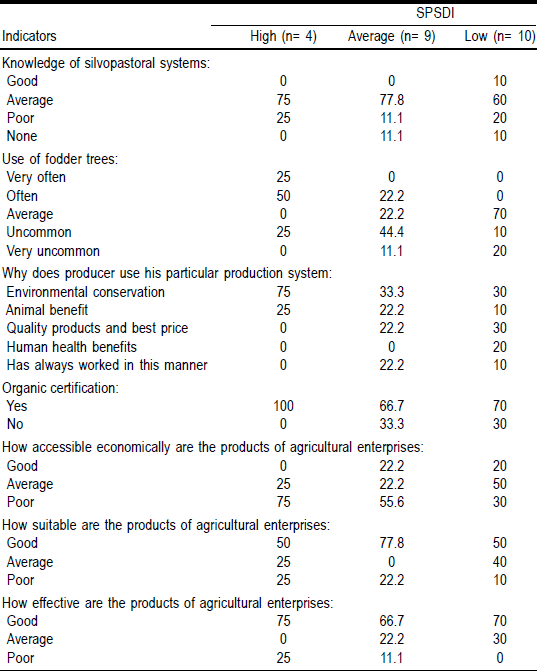
(P>0.05).
Currently, it is among the reasons why they carried out their production system, 75, 33.3 and 30 % of farmers with high, medium and low SPSDI respectively, noted the conservation of the environment, but producers of the last two levels indicated at 22.2 and 10 % that their reason is that it has always worked in this manner, and it is notable that the percentages related to animal welfare are down, from the highest level of SPSDI (Table 6). The data show that high SPSDI producers are more sensitized regarding environmental conservation, which directly favors the development of the SPS in their LUs. Additionally, 100, 55.6 and 90 % of farmers with high, medium and low SPSDI respectively, noted that it is necessary to take action to improve the environment.
The perception that producers have regarding products from agricultural enterprises (drugs, commercial foods, chemicals, etc.) was that they are economically inaccessible for high level (75 %), medium (55.6 %) and regularly accessible (50 %) for low-level SPSDI. While most at all the three levels agreed that, they are adequate and effective, indicating that producers rely on these products to solve problems that arise in their LUs despite its cost. Summarizing, 50 % of producers with high SPSDI mentioned that the most important type of support that they need to make improvements to their ranch is economic, while for producers with average level (66.7 %) and low (40 %) of SPSDI it is in terms of infrastructure.
Conclusions and implications
Age, schooling and extra income of producers determine the adoption of silvopastoral systems. The lack of additional revenue, marketing problems such as the low price of milk and the sale of animals through intermediaries (coyotaje) have unmotivated and affects 68.9 % of producers. Many just meet their basic needs, especially those who have no additional source of income and it is clear that this situation causes the younger generations to not be interested or have an affiliation for the farm. At all three levels of SPSDI producers said they had average knowledge of SPS, noting that they need further technical assistance from the government, academic and research institutions and other intervention strategies to learn and adopt the technology of agroforestry methods and its benefits. Needed as well are better public policies, providing for the payment of environmental services with more accessible procedures to achieve economic support, not only as a group but individually, as well as medical services, scholarships for the study of their children, among others, to encourage this primary population. The SPS development index generated is a tool that allows for tracking of livestock units in this area.
Acknowlegments
Institutional Research System of the Universidad Autonoma de Chiapas (SIINV-UNACH), for the funding provided for the project in which first author obtained his MS degree. We expressly thank the participating producers for their assistance in this study.
REFERENCES
1. Ibrahim M, Rojas J, Sinclair F, Villanueva C. Tecnologías forrajeras para la intensificación de la ganadería y la conservación de los recursos naturales en el trópico. En: Velasco ZME, Pinto RR, Martínez CB. Simp Int Forrajes Trop Prod Anim. México: UNACH; 2005:77-94. [ Links ]
2. Montagnini F, Finney C. Payments for environmental services in Latin America as a tool for restoration and rural development. Ambio 2011;(40):285-297. [ Links ]
3. González J. Costos y beneficios de un sistema silvopastoril intensivo (SSPi), con base en Leucaena leucocephala (Estudio de caso en el municipio de Tepalcatepec, Michoacán, México). Avanc Invest Agropecu 2013;17(3):35-50. [ Links ]
4. Calle Z, Murgueitio E, Chará J. Integración de las actividades forestales con la ganadería extensiva sostenible y la restauración del paisaje. Unasylva 2012;63(1):31-38. [ Links ]
5. Murgueitio E, Chará J, Solarte A, Uribe F, Zapata C, Rivera J. Agroforestería pecuaria y sistemas silvopastoriles intensivos (SSPi) para la adaptación ganadera al cambio climático con sostenibilidad. Rev Col Cienc Pecu 2013;(26):313-316. [ Links ]
6. Xóchitl M, Solorio B. Ganadería sustentable, 2a Etapa del proyecto estratégico de prioridad nacional “Desarrollo y fomento de los sistemas silvopastoriles intensivos como alternativa alimenticia para la producción de carne y leche en regiones tropicales de México”. 1a ed, México: Fundación Produce A.C. Michoacán. 2013. [ Links ]
7. Nahed TJ, Calderón PJ, Aguilar JR, Sánchez MB, Ruiz RJ, Mena Y, et al. Aproximación de los sistemas agrosilvopastoriles de tres microrregiones de Chiapas, México, al modelo de producción orgánica. Avanc Invest Agropecu 2009;13(1):45-58. [ Links ]
8. Nahed TJ, Sánchez MB, Ruiz RJ, Delgadillo PC, Guevara HF. Innovación socio ambiental desde la perspectiva pecuaria: El caso de la transición orgánica en Tecpatán, Chiapas. En: Bello BE, Naranjo PE, Vandame R editores. La otra innovación para el ambiente y la sociedad en la frontera sur de México, México: ECOSUR; 2012:134-144. [ Links ]
9. Morgan L. Practical strategies for combining qualitative and quantitative methods: applications to health research. Sage Publications 1998;(3):362-376. [ Links ]
10. Salas JM, Leos JA, Sagarnaga M, Zavala MY. Adopción de tecnologías por productores beneficiarios del programa de estímulos a la productividad ganadera (PROGAN) en México. Rev Mex Cienc Pecu 2013;4(2):243-254. [ Links ]
11. Marín Y, Ibrahim M, Villanueva C, Ramírez E, Sepúlveda C. Los impactos de un proyecto silvopastoril en el cambio de uso de la tierra y alivio de la pobreza en el paisaje ganadero de Matiguas, Nicaragua. Agroforestería de las Américas 2006;(45):109-116. [ Links ]
12. Casasola F, Ibrahim M, Sepúlveda C, Ríos N, Tobar D. Implementación de sistemas silvopastoriles y el pago de servicios ambientales en Esparza, Costa Rica: una herramienta para la adaptación al cambio climático en fincas ganaderas. En: Sepúlveda C, Ibrahim M. Políticas y sistemas de incentivos para el fomento y adopción de buenas prácticas agrícolas como una medida de adaptación al cambio climático en América Central, Costa Rica. CATIE 2009:169-188. [ Links ]
13. Forero C, Rojas G, Arguelles J. Capital social y capital financiero en la adopción de tecnologías ganaderas en zonas rurales altoandinas de Colombia. Corpoica Cienc Tecnol Agropecu 2013;14(2):149-163. [ Links ]
14. Pagiola S, Arcenas A, Platais G. Can payments for environmental services help reduce poverty? An exploration of the issues and the evidence to date from Latin America. World Develop 2005;33(2):237-253. [ Links ]
15. Zapata A, Murgueitio E, Mejía C, Zuluaga A, Ibrahim M. Efecto del pago por servicios ambientales en la adopción de sistemas silvopastoriles en paisajes ganaderos de la cuenca media del río La Vieja, Colombia. Agroforestería de las Américas 2007;(45):86-92. [ Links ]
16. Plazas B, Lascano C. Utilidad de Cratylia argentea cv. Veranera en sistemas de producción de leche: lecciones aprendidas con productores en el piedemonte de los llanos orientales de Colombia. Velasco ZME, Pinto RR, Martínez CB. editores. Simp Int Forrajes Trop Prod Anim. México: UNACH; 2005:67-76. [ Links ]
17. Aldy J, Hrubovcak J, Vasavada J. The role of technology in sustaining agriculture and the environment. Ecological Econom 1998;(26):81-96. [ Links ]
18. Calderón J, Nahed J, Sánchez B, Herrera O, Aguilar R, Parra M. Estructura y función de la cadena productiva de carne de bovino en la ganadería ejidal de Tecpatán, Chiapas, México. Avanc Invest Agropecu 2012;16(2):45-61. [ Links ]
19. Clavero T, Suarez J. Limitaciones en la adopción de los sistemas silvopastoriles en México. Pastos y Forrajes 2006;29 (3):1-6. [ Links ]
20. Mahecha L. Importancia de los sistemas silvopastoriles y principales limitantes para su implementación en la ganadería colombiana. Rev Col Cienc Pecu 2003;16(1):11-18. [ Links ]
Received: May 14, 2014; Accepted: July 28, 2014











 text in
text in 

